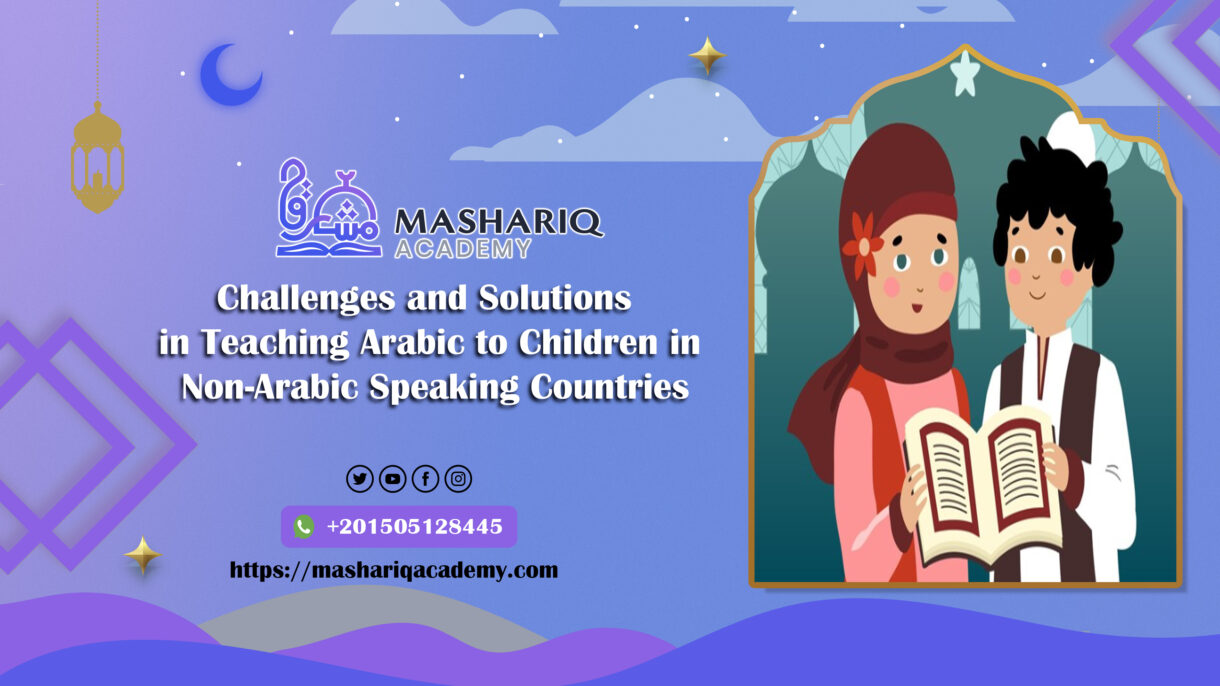
Teaching Arabic to children in non-Arabic-speaking countries presents unique challenges. Arabic, as a Semitic language, differs significantly from most Western languages in its script, grammar, and phonetics. These differences, coupled with cultural and environmental factors, create obstacles for educators and parents striving to instill proficiency in the language. This article explores the challenges and proposes practical solutions to make the learning journey effective and enjoyable.
I. The Importance of Teaching Arabic to Children Abroad
Arabic is one of the world’s most spoken languages, with over 400 million speakers. For many families living in non-Arabic-speaking countries, teaching Arabic is more than linguistic education; it’s about preserving cultural identity and fostering connections to heritage. Additionally, the ability to read and understand Arabic is essential for religious purposes for Muslims, as it allows them to access the Quran in its original language.
II. Challenges in Teaching Arabic
1. Limited Exposure to the Language
In non-Arabic-speaking countries, children are often surrounded by a dominant language, such as English, French, or German. This environment restricts their exposure to Arabic, making it harder to develop fluency.
- Impact: Limited exposure reduces vocabulary acquisition and weakens listening and speaking skills.
2. Complexity of the Arabic Script
Arabic’s script, which is written from right to left and features connected letters with varying forms depending on their position in a word, can be intimidating for beginners.
- Impact: Children may struggle with handwriting, recognizing letters in different contexts, and understanding the rules of diacritical marks (tashkeel).
3. Dialect vs. Modern Standard Arabic (MSA)
Arabic is a diglossic language, meaning there is a significant difference between the colloquial dialects spoken in daily life and MSA, used in formal settings.
- Impact: Children may find it confusing to navigate between the dialect spoken at home and the MSA taught in schools or used in reading materials.
4. Lack of Qualified Teachers and Resources
Finding qualified Arabic teachers in non-Arabic-speaking countries can be challenging. Many available teachers lack pedagogical training, especially in teaching children.
- Impact: Poor teaching methods can result in frustration and hindered progress. Additionally, Arabic learning resources, such as books, apps, and multimedia tools, are often limited in availability or quality.
5. Cultural Disconnect
Learning a language is closely tied to understanding its cultural context. In non-Arabic-speaking countries, children may have limited opportunities to experience Arabic culture through media, traditions, or social interactions.
- Impact: This disconnect can reduce motivation and engagement in learning.
6. Competing Priorities
Children in non-Arabic-speaking countries often have busy schedules filled with schoolwork, extracurricular activities, and social commitments. Arabic lessons may be seen as an additional burden.
- Impact: Lack of time and prioritization can slow progress and diminish interest.
7. Negative Perceptions or Stigmas
In some regions, Arabic may be associated with negative stereotypes or political sensitivities. Such perceptions can discourage children from learning the language or reduce parental support.

III. Solutions to Overcome Challenges
1. Creating an Immersive Environment
One of the most effective ways to teach Arabic is by creating an immersive environment at home and in the community.
- At Home:
- Speak Arabic regularly during daily interactions.
- Introduce Arabic media, such as cartoons, songs, and audiobooks, to make the language fun and relatable.
- Label household items in Arabic to build vocabulary.
- In the Community:
- Join Arabic-speaking social groups or communities.
- Attend cultural events or activities to deepen cultural connections.
2. Simplifying the Learning Process
Breaking down the complexity of the Arabic script and grammar into manageable steps can help children build confidence.
- Strategies:
- Use visual aids, such as colorful charts and flashcards, to teach letters and words.
- Start with simple vocabulary and gradually introduce more complex concepts.
- Practice letter formation using tracing activities and fun games.
3. Balancing Dialects and MSA
While MSA is essential for reading and formal communication, teaching children the dialect spoken at home can make the learning process more practical and engaging.
- Approach:
- Introduce MSA alongside the home dialect, highlighting similarities and differences.
- Use storybooks and media that blend both forms of Arabic to provide context.
4. Leveraging Technology and Interactive Tools
Modern technology offers a wealth of resources to make learning Arabic more interactive and enjoyable.
- Recommended Tools:
- Language apps like Duolingo or Memrise that offer gamified learning.
- Online platforms providing interactive lessons, such as Noor Academy or Alifbee.
- YouTube channels dedicated to teaching Arabic to children.
5. Hiring Qualified Teachers
Investing in skilled teachers who specialize in teaching Arabic as a second language can make a significant difference.
- Key Qualities of an Ideal Teacher:
- Patience and ability to engage children.
- Knowledge of effective teaching methodologies.
- Cultural sensitivity to connect with diverse learners.
6. Integrating Arabic into Daily Life
Embedding Arabic into children’s routines can reinforce learning.
- Examples:
- Encourage children to write grocery lists or journal entries in Arabic.
- Practice Arabic during meal times by naming foods or having conversations.
- Use Arabic for religious practices, such as prayer or reciting Quranic verses.
7. Making Learning Fun
Turning lessons into games, challenges, or creative activities can sustain children’s interest.
- Ideas:
- Create treasure hunts where children find items labeled in Arabic.
- Use storytelling to teach vocabulary and grammar.
- Reward progress with small incentives or certificates.
8. Promoting a Positive Attitude
Parents and educators must foster a supportive and encouraging environment.
- Tips:
- Celebrate milestones, no matter how small.
- Avoid criticism or comparisons to others.
- Emphasize the value of bilingualism and its benefits for future opportunities.
IV. Success Stories: Real-Life Examples
1. The Role of Cultural Centers
Cultural centers and mosques often play a pivotal role in teaching Arabic abroad. For example, a family in France shared how their local mosque’s weekend classes, combined with Arabic TV shows at home, helped their children achieve fluency.
2. Technology as a Game-Changer
A family in Canada used apps like “Little Thinking Minds” and “Alif Baa Taa” to teach their children Arabic. The gamified learning experience kept the children engaged, leading to significant progress in reading and writing.
3. Homeschooling Success
In the United States, a homeschooling mother created a custom curriculum blending Arabic lessons with cultural activities, such as cooking Arabic dishes and celebrating traditional holidays. Her children developed a strong connection to the language and culture.
V. Long-Term Benefits of Learning Arabic
1. Cognitive Advantages
Learning Arabic enhances problem-solving skills and improves memory, as it requires recognizing patterns in a unique script and grammar system.
2. Career Opportunities
Arabic proficiency opens doors to careers in translation, international relations, and global business.
3. Cultural and Religious Enrichment
Understanding Arabic allows children to connect deeply with their heritage, understand Islamic texts, and appreciate the richness of Arab culture.
Teaching Arabic to children in non-Arabic-speaking countries is undoubtedly challenging, but with the right strategies, resources, and support, it is a rewarding endeavor. By creating an immersive environment, leveraging technology, and fostering a positive attitude, parents and educators can help children develop not only linguistic skills but also a lifelong appreciation for the Arabic language and culture.
This process is a journey of love and dedication, preserving a vital link to heritage while equipping children with skills that will benefit them for a lifetime.







